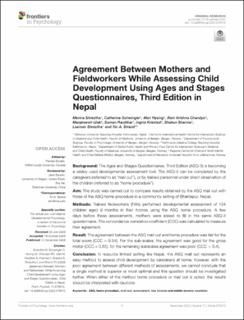| dc.contributor.author | Shrestha, Merina | |
| dc.contributor.author | Schwinger, Catherine | |
| dc.contributor.author | Hysing, Mari | |
| dc.contributor.author | Chandyo, Ram K | |
| dc.contributor.author | Ulak, Manjeswori | |
| dc.contributor.author | Ranjitkar, Suman | |
| dc.contributor.author | Kvestad, Ingrid | |
| dc.contributor.author | Sharma, Shakun | |
| dc.contributor.author | Shrestha, Laxman | |
| dc.contributor.author | Strand, Tor A | |
| dc.date.accessioned | 2021-03-04T14:12:08Z | |
| dc.date.available | 2021-03-04T14:12:08Z | |
| dc.date.created | 2020-11-13T13:24:24Z | |
| dc.date.issued | 2020 | |
| dc.Published | Frontiers in Psychology. 2020, 11 . | |
| dc.identifier.issn | 1664-1078 | |
| dc.identifier.uri | https://hdl.handle.net/11250/2731698 | |
| dc.description.abstract | Background: The Ages and Stages Questionnaires, Third Edition (ASQ-3) is becoming a widely used developmental assessment tool. The ASQ-3 can be completed by the caregivers (referred to as “mail out”), or by trained personnel under direct observation of the children (referred to as “home procedure”).
Aim: The study was carried out to compare results obtained by the ASQ mail out with those of the ASQ home procedure in a community setting of Bhaktapur, Nepal.
Methods: Trained fieldworkers (FWs) performed developmental assessment of 134 children aged 9 months in their homes using the ASQ home procedure. A few days before these assessments, mothers were asked to fill in the same ASQ-3 questionnaire. The concordance correlation coefficient (CCC) was calculated to measure their agreement.
Result: The agreement between the ASQ mail out and home procedure was fair for the total score (CCC = 0.54). For the sub-scales, the agreement was good for the gross motor (CCC = 0.65), for the remaining subscales agreement was poor (CCC < 0.4).
Conclusion: In resource limited setting like Nepal, the ASQ mail out represents an easy method to assess child development by caretakers at home; however, with the poor agreement between different methods of assessments, we cannot conclude that a single method is superior or most optimal and this question should be investigated further. When either of the method home procedure or mail out is opted, the results should be interpreted with cautions. | en_US |
| dc.language.iso | eng | en_US |
| dc.publisher | Frontiers Media | en_US |
| dc.rights | Navngivelse 4.0 Internasjonal | * |
| dc.rights.uri | http://creativecommons.org/licenses/by/4.0/deed.no | * |
| dc.title | Agreement Between Mothers and Fieldworkers While Assessing Child Development Using Ages and Stages Questionnaires, Third Edition in Nepal | en_US |
| dc.type | Journal article | en_US |
| dc.type | Peer reviewed | en_US |
| dc.description.version | publishedVersion | en_US |
| dc.rights.holder | Copyright 2020 Shrestha, Schwinger, Hysing, Chandyo, Ulak, Ranjitkar, Kvestad,
Sharma, Shrestha and Strand. | en_US |
| dc.source.articlenumber | 579412 | en_US |
| cristin.ispublished | true | |
| cristin.fulltext | original | |
| cristin.qualitycode | 2 | |
| dc.identifier.doi | 10.3389/fpsyg.2020.579412 | |
| dc.identifier.cristin | 1847745 | |
| dc.source.journal | Frontiers in Psychology | en_US |
| dc.source.40 | 11 | |
| dc.identifier.citation | Frontiers in Psychology. 2020, 11, 579412. | en_US |
| dc.source.volume | 11 | en_US |

